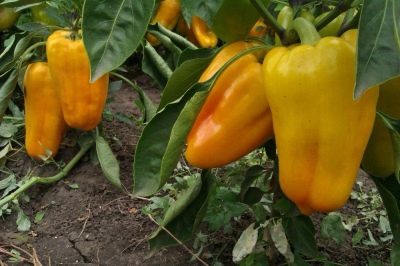
- Authors: Ognev V.V., Klimenko N.N., Kostenko A.N.
- Year of approval: 2015
- Growth type: medium-sized
- Fruit shape: conical
- Fruit weight, g: 200-350
- Fruit color: greenish-white in technical ripeness, yellow in biological ripeness
- Ripening terms: mid-season
- Average yield: 4.7 kg / m2
- Appointment: universal
- Growing conditions: greenhouse, open ground
Pepper Gladiator Agro is a widespread variety in the post-Soviet space due to its valuable qualities.
Description of the variety
Pepper Gladiator Agro is considered author's. It was bred by a group of breeders, which include V.V. Ognev, N.N.Klimenko, A.N. Now it is planted in greenhouses and hotbeds, in the open field. In some regions, seeds for seedlings begin to be planted as early as late February - early March.
Main features of Gladiator Argo:
- compact, semi-sprawling bushes give ripe fruits after 115-130 days;
- the ripening period and the amount of pepper can be optimized by observing the growing conditions and proper agricultural practices;
- grown in open ground and greenhouse conditions, in film tunnels;
- high yields and transportability, making it an excellent choice for commercial breeding;
- fruits of universal purpose - for eating fresh, cooking and preservation for the winter.
Reviews of gardeners are invariably favorable. Experts note unpretentiousness, resistance to adverse environmental conditions, good immunity to common diseases of this type of cultivated plants. Productivity, subject to the recommended agricultural practices, reaches high rates.
Characteristics of the appearance of plants and fruits
The bushes of Gladiator Agro are low, slightly branched, from 40 to 55 cm. The average foliage is dark green, small in size, the branches are vigorous, they hold a significant amount of fruits of a truncated pyramidal shape.
Fruits with moderate gloss, ribbing on them is poorly expressed. In the initial stage, it is green, as it ripens, it becomes yellow. At the stage of full ripeness, they reach an intense yellow color, slightly fading to orange.
The variety is distinguished by the abundance of juice and the thickness of the fruit walls, which reaches 7 mm. The weight of one fruit is 200-350 g, in length - up to 12 cm. Each fruit is of excellent presentation, attractive in appearance and retains its aesthetic visualization for a long time.
When transported over long distances, it retains its juiciness and characteristic peppery aroma. Therefore, it is always mentioned in the ranking of priority varieties recommended for commercial cultivation.
Purpose and taste
Fragrant, thick-walled, large and tasty fruits are considered universal for processing, conservation and culinary needs. Already in the light green stage of technical ripeness, peppers can:
- eat fresh, slicing into salads with various ingredients;
- subject to heat treatment - fry, stew, stuff, add to first courses, vegetable and meat culinary delights;
- harvested for the winter - salt, ferment, pickle, freeze, include in the composition of assorted vegetables and monoproducts for cooking;
- to cook gourmet canned food - in honey, stuffed, in tomato and garlic sauce.
Yellow pepper contains many useful components - vitamins, pectin, which are preserved even after heat treatment. Gladiator Agro has a delicate taste that retains all the taste characteristics of sweet pepper and its unique aroma. The skin is easily separated from the pulp after frying or boiling. Stuffed peppers with traditional or vegetable filling are especially tasty.
Ripening terms
In different sources, one can find statements that the variety is mid-season or mid-early. They call the terms from 115 to 130 days until full maturation, from the moment of emergence. There is no contradiction in this - the ripening period depends on the growing region and weather conditions.
Yield
With the very minimum care, it is realistic to get 4.7-5.5 kg per sq. m, but the correct agricultural technology allows you to optimize the indicator up to 9-12 kg from a similar area. The bush is abundantly sprinkled with peppers.

To get a large and tasty harvest of pepper, you need to take care of the seedlings in advance. When growing pepper seedlings, you need to correctly determine the sowing time, pre-sowing seed treatment, prepare the necessary container and soil.
Growing and care
Planting pepper seedlings begins in accordance with regional conditions. If the seeds from the originator are processed (this is indicated on the package), you can immediately plant them in prepared containers. After the pick, it is advisable to treat it with a growth stimulant, and during the flowering period and after fruiting, add top dressing to the soil. Peppers need good lighting and regular watering.
Gardeners appreciated its resistance to adverse weather conditions, delicate, but pronounced peppery taste of juicy pulp. The size of the fruit is quite impressive, intense yellow-orange color, rich in vitamins and minerals. The mid-season variety is versatile in the cultivation method and in the field of application.

To harvest a tasty and rich harvest of pepper, you need to comply with all the conditions of agricultural technology, and proper care begins with planting plants. Before planting pepper in open ground, it should be prepared. It is also important to take care of the seedlings and planting space in advance.




For good growth of pepper bushes and active fruiting, you need to regularly apply mineral and organic fertilizing to the soil. It is necessary not only to choose the right formulations, but also to use them at the right stage in the development of culture. The frequency of top dressing is always individual. It depends directly on the composition of the land on your site. The poorer the soil composition, the more often you will need to feed the pepper.

Pepper is one of the most common vegetables in home gardens. This culture is quite stable and unpretentious. However, under certain conditions, this plant can suffer from infections and harmful insects. Before treating peppers for diseases or pests, you need to find out the cause of the problem, otherwise the treatment may be ineffective.





















































































